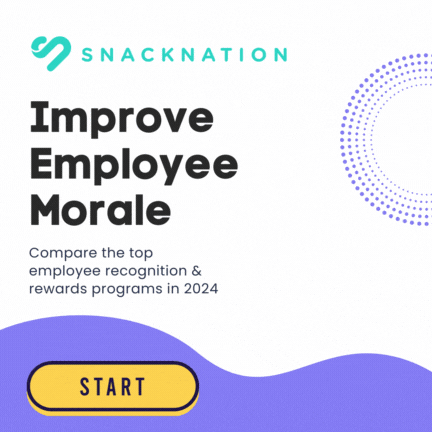Did you know that companies with happy employees outperform the competition by 20%?
Happy employees perform better, stick around longer, and advocate for your company.
So, how do you make and keep your employees happy? Keep them engaged!
Keep reading to become your company’s foremost expert on the topic. You’ll walk away with:
- A clear idea of what employee engagement is and how to explain it to other people
- The benefits for you, those around you, and your company
- Why it matters
- The cost of disengagement
What is employee engagement anyway?
Employee engagement, simply put, is the extent to which an employee’s personal goals and interests align with the vision and goals of the company at which they are employed.
With all the disparate information, opinions, and variables surrounding it, Employee Engagement can be a confusing topic but it doesn’t have to be a mystery.
The Benefits of Employee Engagement
Before we start breaking things down, you might be wondering why you should even care about this employee engagement stuff.
Here are 5 surprising benefits to a company with engaged employees:
- Higher levels of productivity
- A boost to your bottom line
- Better retention rates of your top talent
- An increased sense of health and well-being
- And (surprisingly) decreased healthcare costs
With the right knowledge, the right employee engagement tools, and – most importantly – the proper mindset, it can be a powerful way to transform your organization and improve your bottom line.
And the good news is…you’ve already taken the first step by checking out this guide.
Employee Engagement
We’ve all heard of it. Some of us may even know that it’s important. But why is it important? Better yet, what exactly is it?
First, it might help to clarify what employee engagement is not.
Contrary to popular belief, employee engagement is not the same thing as job satisfaction, nor does it simply mean job happiness.
Believe it or not, individuals can actually be satisfied with their jobs and still be disengaged. (Consider the employee who breezes into the office late each day, leaves early, and still collects a hefty paycheck.)
All engaged employees are happy, but not all happy employees are engaged.
So what’s the difference? The answer lies in performance.
It’s not just happiness or satisfaction that matters, but how those emotions directly relate to the individual’s and company’s performance and productivity.
For our purposes, the definition offered by Emma Bridger (which in turn borrows heavily from ideas first proposed by John Smythe in his book “The Chief Engagement Officer”), works best:
“Employee engagement is “[t]he extent to which people are personally involved in the success of a business.”
Why do we like this definition?
Well, besides the fact that it’s clear and concise, it captures both the performance aspect inherent to engagement, as well as the often-overlooked (but equally critical) emotional component.
Engaged employees will go the extra mile because they feel a strong emotional connection to the organization.
They want their businesses to succeed because they identify with their company’s mission, purpose, or values on a personal level.
Engaged employees go that extra mile because success is personal for them.
As we’ll uncover, these two factors – emotional connection and performance – are the two most important concepts in understanding engagement and creating employee engagement strategies that work.
Engaged Employees…
- Are self-guided
- Have well-defined roles
- Understand their contribution to the organization
- Invest in personal & professional development
- Feel connected to their team & the larger organization
Why Employee Engagement Matters
If you care about engagement, you’re not alone.
So why all this focus on engagement?
Believe it or not, we’re all in the business of employee engagement.
Consider this…
Engagement affects every person inside your organization, and every person inside your organization affects your bottom line.
This idea is best expressed in the Service-Profit Chain, a model first theorized by a group of Harvard Researchers in the nineteen nineties that establishes links between profitability, customer loyalty, and staff engagement.
The formulation traces profitability to the value created by satisfied, loyal, and productive employees.
Businesses, the theory goes, must create the conditions for satisfied and engaged employees, in order to create valuable, loyalty-inspiring experiences for customers, which will ultimately drive profits.
Investing in the skills needed to improve employee engagement is vital for organizations of any size. Well-delivered workshops and training courses can be a great way to engage your staff and drive innovation. Develop facilitation skills in your management team so that any actions you take are more effective, dynamic and cost-effective.
The best business leaders know that an engaged workforce can drive innovation, increase performance and raise productivity, grow the organization, improve customer care, and foster loyalty, both internally and externally.
The Costs of Disengagement
There’s empirical data to back up the importance of engagement as well. According to the latest research, non-engaged employees cost this country billions.
Research firm Gallup recently reported that an astonishing 68.5% of U.S. employees are not engaged in their current roles.
Within that group, 17.5% of the workforce characterize themselves as actively disengaged, which means that they are actively working to undermine the success of their own companies. (Let that last idea sink in for a moment.)
What’s worse, actively disengaged workers are not only unhappy and unproductive themselves, but their negativity actually rubs off on the people around them, turning potentially engaged employees into non-engaged workers.
According to their 2013 State of the American Workplace report, Gallup estimates that active disengagement costs American companies $450 – 550 billion in lost productivity each year.
If you still need convincing that engagement matters, try this on for size – research shows that engaged companies consistently outperform their competition in a number of categories, including profits, productivity, and turnover.
In other words… you can’t afford to ignore employee engagement.
Action Plan
Okay so now you’ve mastered your understanding of employee engagement. But what’s next?
We know it’s costing us billions of dollars but how do we avoid these costs? (After all, who wouldn’t want to work in an office filled with happy employees?)
We’ve created a simple 4-step guide focusing on the most important pillars of engagement which we will be releasing one chapter at a time. All you’ve got to do is stay tuned!














Victoria,
This was beautifully written and so needed in the current work environment.. in so many companies!
I look forward to further engagement articles.
Thank you,
Kerri